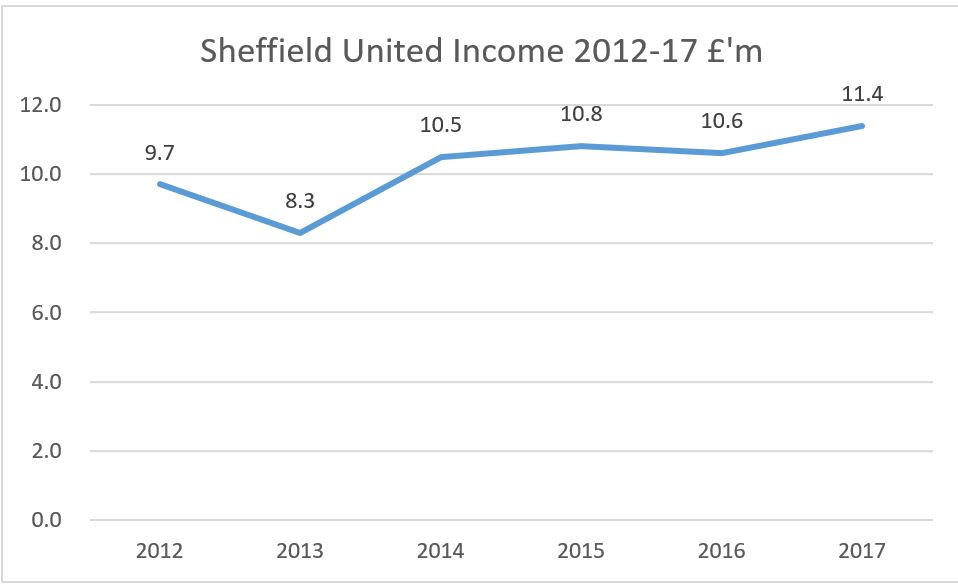Sheffield United: Crushed by the wheels of industry
 Introduction
Introduction
We’ve always considered Sheffield United to be a big club. Whether that’s due to Tony Currie being a favourite player when I was a kid, Brian Deane scoring the first ever Premier League goal, or Sean Bean’s very public support of the club, we’ve always been well supported, with a decent stadium, so one would expect them to be in the top two divisions.
It’s therefore a surprise to see that it took the Blades six years to return to the Championship, since being relegated in 2011.
Key figures for 2016/17
Income £11.4m (up 7.5%).
Wages £10.0m (down 11.5%)
Losses before player sales £7.7m (down 18.1%)
Player signings £3.1 million
Player sales £2.8 million
Income
United have certainly been one of the biggest teams in League One for the last six years. Although they were unable to keep with those clubs who dropped into that division who were receiving parachute payments during that period (Wolves and Wigan come to mind), they had income higher than most other clubs during that period.

In League One the majority of income for a club comes from matchday income, as the EFL TV deal with Sky, and parachute payments, are skewed towards clubs in the Championship.
Attendances were slightly up at an impressive 21,892 (compared to 19,803 in 2015/16), but made little difference to matchday income, as the previous season included a lucrative FA Cup match at Old Trafford.

Broadcast income was slightly up, partially due to EFL clubs receiving a proportion of the new Premier League TV deal with BT and Sky.
Promotion to the Premier League will increase broadcast income to about £6.6 million in 2017/18.
Costs
The main cost for clubs at all levels is wages. United managed to keep a lid on their wages in 2016/17, paying out £10 million, down from £11.4 million. This is still high by League 1 standards (the median is about £4 million).

United have backed their managers during their time in League One in terms of a player budget. Wages have matched or exceeded income three times during that period.
The club had to cut back on wages significantly in 2013 to ensure compliance with FFP rules in League One.
The other main cost is player amortisation. This is accounting talk for the way that clubs deal with player transfers. The fee paid is spread over the life of the contract signed by the player. So a £1 million signing on a four year contract will give an amortisation charge of £250,000 a year.

In addition to this the club showed an impairment of £614,000 during 2016/17. An impairment arises when a club signs a player for a fee, and then realises he is rubbish (or has a career ending injury) and has to write his value down in the accounts. Who this player was for 2016/17 has not been disclosed in the accounts.
A £3.1 million spend on signings in 2016/17, high by League One signings (ten clubs in the division paid no transfer fees), combined with the inspirational management of Blades fan Chris Wilder, meant that the club was promoted with over 100 points.
The club has traded well with their existing playing staff, making significant profits from selling players every season, with the likes of Jamie Murphy, Kyle Walker, Harry Maguire being sold, and generating over £13 million over the six years in League One.

Hidden away at the back of the accounts is a little disclosure that will benefit the club substantially in 2017/18. It shows that United earned over £7 million as a result of sell on fees in respect of former players. Again, no details are given, but the smart money is on a 10% fee for the sales of Kyle Walker to Manchester City and Harry Maguire to Leicester.

Losses
Losses are total income less costs. United’s losses, before taking into account player sales, were £7.7 million in 2016/17, or about £150,000 a week. Total similar losses during the League One years were £31.2 million, although player sales reduced this by £12.5 million.

The club did make a profit of over £30 million in 2013/14, but this is more to do with the dark arts of accounting than actual trading. This arose when another member of the group wrote off a £30 million loan.
Summary
United have returned to where many would consider their natural place is in the football hierarchy, but it has taken time and a lot of money to achieve promotion.
Being competitive in the Championship is expensive (we estimate losses to exceed £300 million for clubs in 2016/17).
The ownership of the club is a little muddy. The McCabe family, who had owned the club for a long time, sold a 50% share of the parent company Blades Leisure Limited to a Saudi investor via a company called UTB LLC, registered in the West Indies in 2013. Hopes of a Manchester City style splashing of the cash from Middle East ownership have never materialised though. This may change perhaps in the Championship, with the allure of Premier League exposure being so close.
In recent months there has been musical chairs in the boardroom, with directors leaving and then returning. It would appear that the McCabe family, who have bankrolled the losses for many years, are still in effective control.

The Numbers
